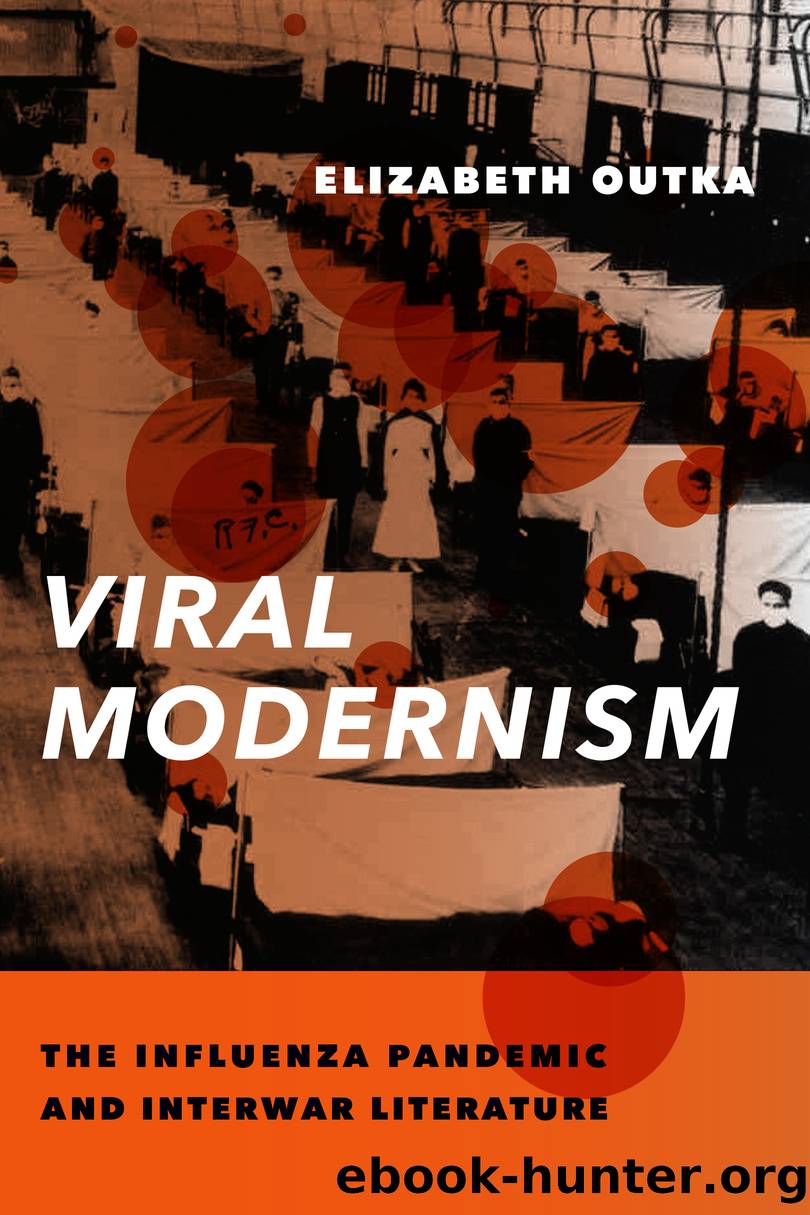Viral Modernism by Elizabeth Outka;

Author:Elizabeth Outka;
Language: eng
Format: epub
Publisher: Lightning Source Inc. (Tier 3)
A PARTICULAR FORM OF VIOLENCE
I’ve focused on the way “The Second Coming” evokes a viral-like threat and suggests a body experiencing an illness-based violence. Before turning to the way the poem registers the repercussions of such violence on the broader society, I pause here to highlight the distinctions and continuities between the violence within “The Second Coming” and the violence in other poems. I turn to specific moments in three of the most famous poems of Yeatsean violence: “Easter 1916,” “Nineteen Hundred and Nineteen,” and “Leda and the Swan.”38 In the first poem, written before the pandemic, Yeats ponders an explicitly political violence, mulling over whether the sacrifice of the Irish revolutionaries executed by England might in the end be worthwhile, though he has his doubts. The tone of the poem is markedly different from “The Second Coming,” and some of this difference arises not from the type of violence depicted but from the stage it has reached. “The Second Coming” occurs within a still unfolding destruction, the poem’s present-tense structure capturing the body’s suffering and terror as it happens. “Easter 1916,” a poem largely in the past tense, takes place in the aftermath of violence, the speaker sorrowful but also thoughtful, calm, and reflective. The tonal difference also suggests the forms of violence each poem explores. Sarah Cole describes the violence within “Easter 1916” as in part “enchanted,” capable of generative possibilities.39 The violence represented by the revolutionaries might still be placed within a structure of meaning—their actions might well grant more rights, eventually, to Ireland. While Yeats notes that “Too long a sacrifice / Can make a stone of the heart,”40 gripping the revolutionaries in a single-minded pursuit where their humanity is potentially jeopardized, the violence they represent remains within a sacrificial structure capable of bringing gain. The additional violence suggested in the poem—the execution of the revolutionaries by the English state—is mentioned only by implication, and even this violence might be mitigated. “England,” the speaker muses, “may keep faith.”41 By contrast, part of the terror of “The Second Coming” is how outside the sacrificial structure the violence seems to be, how purposeless and fruitless this “mere anarchy” is.42 As I investigate in the next section, Yeats may evoke a Second Coming model and explain the anarchy through his elaborate theories on historical epochs, but the atmosphere of violence remains frighteningly unstructured, produced by an unseen force and potentially increasing with the arrival of something inhuman. By 1919, Yeats had grown increasingly disillusioned with political violence, but “The Second Coming” registers a violence without meaning or even a visible enemy.
The representations of the perpetrators are also markedly different in the two poems and highlight the distinctions between human- and illness-based violence. In “Easter 1916,” Yeats identifies in concise but vivid detail the individual revolutionaries, who are both instigators of a violence that carries a “terrible beauty” and also its victims.43 He notes specific strengths among the group—poetic talent, daring, courage, sweetness, horsemanship—and acknowledges weaknesses. The other perpetrator—England—is named
Download
This site does not store any files on its server. We only index and link to content provided by other sites. Please contact the content providers to delete copyright contents if any and email us, we'll remove relevant links or contents immediately.
| Ancient & Classical | Arthurian Romance |
| Beat Generation | Feminist |
| Gothic & Romantic | LGBT |
| Medieval | Modern |
| Modernism | Postmodernism |
| Renaissance | Shakespeare |
| Surrealism | Victorian |
4 3 2 1: A Novel by Paul Auster(11026)
The handmaid's tale by Margaret Atwood(6834)
Giovanni's Room by James Baldwin(5868)
Big Magic: Creative Living Beyond Fear by Elizabeth Gilbert(4713)
Asking the Right Questions: A Guide to Critical Thinking by M. Neil Browne & Stuart M. Keeley(4557)
On Writing A Memoir of the Craft by Stephen King(4203)
Ego Is the Enemy by Ryan Holiday(3977)
Ken Follett - World without end by Ken Follett(3967)
The Body: A Guide for Occupants by Bill Bryson(3787)
Bluets by Maggie Nelson(3702)
Adulting by Kelly Williams Brown(3661)
Guilty Pleasures by Laurell K Hamilton(3576)
Eat That Frog! by Brian Tracy(3502)
White Noise - A Novel by Don DeLillo(3427)
The Poetry of Pablo Neruda by Pablo Neruda(3356)
Alive: The Story of the Andes Survivors by Piers Paul Read(3300)
The Bookshop by Penelope Fitzgerald(3220)
The Book of Joy by Dalai Lama(3211)
Fingerprints of the Gods by Graham Hancock(3205)
